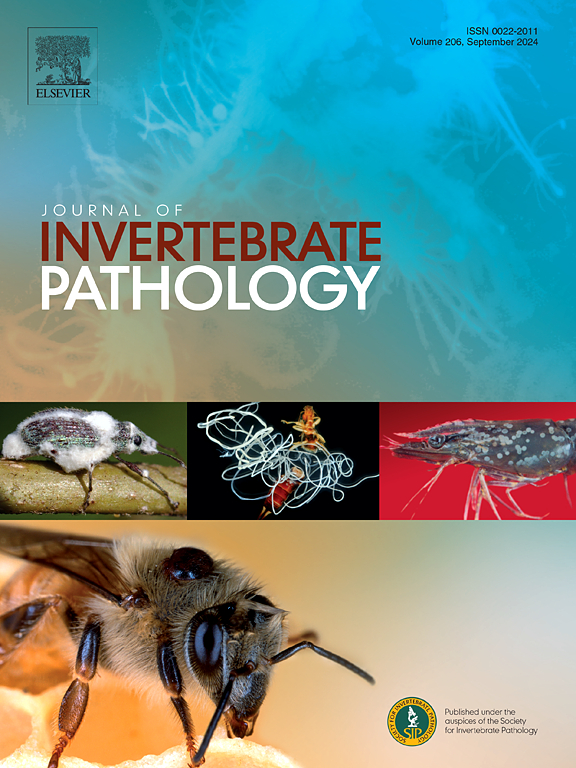Experimental infection study reveals differential susceptibilities of Penaeus monodon and Penaeus vannamei to Enterocytozoon hepatopenaei
IF 3.6
3区 生物学
Q1 ZOOLOGY
引用次数: 0
Abstract
Enterocytozoon hepatopenaei (EHP) is a significant pathogen affecting penaeid shrimp, particularly farmed whiteleg shrimp Penaeus vannamei, causing hepatopancreatic microsporidiosis (HPM). Although initially reported in tiger shrimp P. monodon, limited data exists on its current impact and pathogenic potential of EHP infection in tiger shrimp due to the shift toward farming P. vannamei. This study aimed to compare the susceptibility of P. monodon and P. vannamei via experimental oral EHP challenge. Challenge group shrimps were fed commercial feed mixed with minced EHP-infected hepatopancreatic tissue (1:1) containing 10⁶ copies/ng DNA for four days, while control groups received commercial pellet feed. Over 90 days, hepatopancreas and fecal samples were aseptically sampled and PCR-tested for EHP presence on days 7, 15, 30, 60, and 90 post-challenge (dpc). EHP loads, quantified using qPCR, were higher in P. vannamei (1.5–5.3 × 105 copies/μL DNA) compared to P. monodon (5.6–10.3 × 103 copies/μL DNA). Challenged P. monodon tested EHP-positive only in nested step SWP-PCR till 90 dpc. Further, infection was confirmed through wet mount, calcofluor white stain, histology, and in situ hybridization. EHP-challenged P. monodon had a higher survival rate (75 %) than P. vannamei (37.5 %). This first experimental report on EHP in P. monodon indicates it is less susceptible than P. vannamei, suggesting that the reintroduction of P. monodon can help deal with the EHP crisis the shrimp industry is currently going through.

实验感染研究表明,单对虾和凡纳滨对虾对肝芽胞虫的敏感性存在差异
肝openaeenterocytozoon hepatopenaei (EHP)是一种影响对虾,特别是养殖的凡纳滨对虾(Penaeus vanamei)的重要病原体,可引起肝胰腺微孢子虫病(HPM)。虽然最初在虎虾中报道了单斑绦虫,但由于转向养殖凡纳滨绦虫,目前关于其在虎虾中感染EHP的影响和致病潜力的数据有限。本研究旨在通过实验性口腔EHP感染,比较单顿假单胞菌和凡纳梅假单胞菌的易感性。攻毒组用含有10 26拷贝/ng DNA的猪大肠杆菌感染肝胰腺组织(1:1)混合饲料饲喂4天,对照组用颗粒饲料饲喂4天。在90天内,对肝胰脏和粪便样本进行无菌取样,并在攻毒后(dpc)第7、15、30、60和90天进行pcr检测EHP的存在。qPCR结果显示,凡纳梅的EHP负荷(1.5 ~ 5.3 × 105拷贝/μL DNA)高于单叶假单胞假单胞假单胞假单胞假单胞假单胞假单胞假单胞假单胞假单胞假单胞假单胞假单胞假单胞假单胞假单胞假单胞假单胞假单胞假单胞。巢式步进SWP-PCR检测到90 dpc时,攻毒单胞菌仅呈ehp阳性。此外,通过湿载、钙白染色、组织学和原位杂交证实感染。ehp攻毒的单斑单胞疟原虫存活率为75%,高于南美单胞单胞疟原虫(37.5%)。这是第一份关于单斑绦虫EHP的实验报告,表明单斑绦虫对EHP的易感程度低于凡纳梅单斑绦虫,这表明单斑绦虫的重新引入有助于解决虾业目前正在经历的EHP危机。
本文章由计算机程序翻译,如有差异,请以英文原文为准。
求助全文
约1分钟内获得全文
求助全文
来源期刊
CiteScore
6.10
自引率
5.90%
发文量
94
审稿时长
1 months
期刊介绍:
The Journal of Invertebrate Pathology presents original research articles and notes on the induction and pathogenesis of diseases of invertebrates, including the suppression of diseases in beneficial species, and the use of diseases in controlling undesirable species. In addition, the journal publishes the results of physiological, morphological, genetic, immunological and ecological studies as related to the etiologic agents of diseases of invertebrates.
The Journal of Invertebrate Pathology is the adopted journal of the Society for Invertebrate Pathology, and is available to SIP members at a special reduced price.

 求助内容:
求助内容: 应助结果提醒方式:
应助结果提醒方式:


